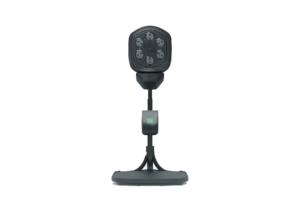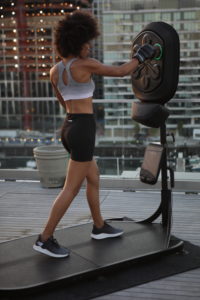It is no surprise during a pandemic that home gyms are on the rise. Some health and fitness companies are betting that people will continue working out at home, even after gyms nationwide fully reopen.
What is surprising is how far home gyms have come. We are not talking about Jane Fonda and a Thigh Master in your living room anymore.
The future of home workouts is a wireless, full-body workout, with a super sleek design, imagined by an engineer. This month, the Leader’s Edge steps into the ring with Jeff Morin, CEO and co-founder of smart fitness company Liteboxer.
– Emily Pappas, The Engineering 100

How has your technical background equipped you for your role at Liteboxer? Have you always been entrepreneurial?
My technical background as an MIT graduate and engineer has a major impact for my role as co-founder at Liteboxer. MIT pushes you to your limits, breaks you down, and helps reshape you to be the best you can be both technically and personally. Liteboxer is a technology company, so I use my technical background daily to make decisions and guide each of the teams to success. While in school, I had the chance to meet and work with some astonishingly smart people, many who were much smarter than I will ever be. At Liteboxer, our team is also built of incredibly smart people, and I use those same communication skills to guide our crew to success.

Liteboxer’s footprint is 37.5″ x 55.5″ and can be broken down for easy storage.
I’ve always been an entrepreneur at heart. I remember playing Legos with my siblings and cousins and creating currencies based on part types so that we could create trade platforms for building and sharing the different pieces. The dream of developing new devices and experiences that push society forward has inspired me throughout my career.
What was the engineering & design/prototype process like? What were some of the early product iterations and how did you learn and adapt from them?
The engineering and design process at Liteboxer has been uniquely organic. Todd Dagres came to me with his idea to make home boxing more interactive with LEDs and music, and I latched onto that idea. We started prototyping with some simple Arduino-based designs that became more and more intricate with each iteration. We started off with flashing indicators that were meant to be reactionary but found the experience to be more like whack-a-mole. As we integrated more LEDs and music, we found that the ability to telegraph hits elevated the user experience, which led to our patented runway design. Over time, we continuously heard that heavy bags had no place in the living room or bedroom. We took cues from other home fitness products that celebrated sleek-looking hardware and developed a platform that required no additional weights or water. As we introduced early versions of the product to testers, we saw how trainers latched onto the idea of being able to reach larger audiences. This lead us down the path of creating trainer-led sessions in addition to the quickplay style we originally envisioned.

Box to the beat with Liteboxer’s rhythm technology™️ which syncs each light to the beat.
What was the process for transforming a physical boxing bag into a connected fitness platform?
What were your priorities?
For any consumer-grade product, you have to think about all the things that could go wrong in someone’s home. Add the fact that your customers will be punching your product with electronics and things get even more complicated. Durability has been a key consideration throughout our development process from both the hardware and software side. User experience is KEY, and we wanted to ensure that the experience was delightful.
When shopping for home furniture, people look for more than just functionality, they also want something that looks nice. The same goes for in-home fitness. Creating something that not only felt great but looked amazing in your home was a high priority.
What lessons have you learned along the way that you could share with other entrepreneurial engineers?
One major lesson I’ve learned for hardware is the importance of a solid manufacturing team. While engineers make the blueprints for your design, the manufacturing team translates those blueprints into a language that can be understood by the factory. They also ensure that parts are built and assembled to the drawing specifications and tested at the end of the line. Poor quality control and manufacturing practices can mean costly repairs and returns. Lastly, the manufacturing team aligns with the sales team so that goods are built and delivered according to the demand schedule. This can be a careful juggling act with seasonality, partnerships and social engagement changes.

Top boxing trainers lead you through multi-round workouts. Choose your trainer style and level.
What’s your next project?
Currently, our goal for Liteboxer is to be a chore-free full-body workout that people actually want to do. We plan to continue the development of our “engagement” platform by improving the software and hardware. There are many opportunities in the health and wellness sector with neurological and rehabilitation benefits from our mind and body programming. We’re also developing some software-only platforms to extend our ability to reach more consumers.
The holidays are coming. Where can we tell our readers to buy their own Liteboxer?
Readers can buy their own Liteboxer on our website, Liteboxer.com! Our warehouse is stocked with inventory for the holiday season and we’re excited to announce that their Liteboxer ships the next day after they order.
